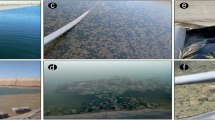Abstract
In the estuaries near Falmouth (Cornwall, UK) levels of dissolved copper and zinc are high, due to drainage of copper and tin mines. Phytoplankton species composition in the autumn of 1989 deviated in the metal-contaminated Restronguet Creek from that in other estuarine branches,viz. Fal, Tresillian and Percuil. In the riverine part of Restronguet Creek (Carnon River)Euglena mutabilis, known as an acidophilic (pH 3) metal-resistant flagellate, occurred at micromolar Cu and Zn, whereas in the clean riversChlamydomonas sp. andOocystis sp. occurred at nanomolar Cu and Zn. An ordination analysis revealed the following patterns in Cu, Zn and phytoplankton species composition in the poly- and euhaline waters. Seston-bound Zn and dissolved Zn were in equilibrium,Katodinium rotundatum is Zn-tolerant, andSkeletonema costatum occurred in water with high contents of Cu in seston. However, none of the variables in these patterns correlated at a significant level (p>0.05). The results show that algae-metal interactions are complicated, and that statistical correlations foundin situ need experimental verification.
Similar content being viewed by others
References
BAKKER, C., P.M.J. HERMAN and M. VINK, 1990. Changes in seasonal succession of phytoplankton induced by the storm-surge barrier in the Oosterschelde (S.W. Netherlands). J. Plankton Res., 12: 947–972.
BRAND L.E., W.G. SUNDA and R.R.L. GUILLARD, 1986. Reduction of marine phytoplankton reproduction rates by copper and cadmium. J. exp. mar. Biol. Ecol., 96: 225–250.
BROWN, L.M., B.T. HARGRAVE and M.D. MACKINNON, 1981. Analysis of chlorophyll-a in sediments by high-pressure liquid chromatography. Can. J. Fish. Aquat. Sci., 38: 205–214.
BRYAN, G.W., P.E. GIBBS, L.G. HUMMERSTONE and G.R. BURT, 1987. Copper, zinc, and organotin as long-term factors governing the distribution of organisms in the Fal Estuary in Southwest England. Estuaries, 10: 208–219.
FOSTER, P.L., 1977. Copper exclusion as a mechanism of heavy metal tolerance in a green alga. Nature, 269: 322–323.
HALL, J., F.P. HEALY and G.G.C. ROBINSON, 1989. The interaction of chronic copper toxicity with nutrient limitation in chemostat cultures ofChlorella. Aquat. Toxicol., 14: 15–26.
HARGREAVES, J.W., E.J.H. LLOYD and B.A. WHITTON, 1975. Chemistry and vegetation of highly acidic streams. Freshwat. Biol. 5: 563–576.
JONGMAN, R.H.G., C.J.F. TER BRAAK and O.F.R. VAN TONGEREN (1987). Data analysis in community and landscape ecology. Pudoc, Wageningen.
REVIS, N.J.P., A.G.A. MERKS, P. VALENTA and H. RÜTZEL, 1989. Heavy metal uptake by plankton and other seston particles. Chem. Speciation Bioavail., 1: 31–37.
RIJSTENBIL, J.W., 1987. Phytoplankton composition of stagnant and tidal ecosystems in relation to salinity, nutrients, light and turbulence. Neth. J. Sea Res., 21: 113–123.
RIJSTENBIL, J.W. and J.A. WIJNHOLDS, 1991. Copper toxicity and adaptation in the marine diatomDitylum brightwellii. Comp. Biochem. Physiol., 100C: 147–150.
STRICKLAND, J.D.H. and T.R. PARSONS, 1968. A practical handbook of seawater analysis. Fish. Res. Bd. Can., 167: 1–311.
TER BRAAK, C.J.F., 1988. CANOCO — A FORTRAN program for community ordination by (partial) (detrended) (canonical) correspondence analysis (version 2.1) — TNO Institute of Applied Computer Science, Wageningen, The Netherlands, 95 pp.
THOMAS, W.H., and D.L.R. SEIBERT, 1977. Effects of copper on the dominance and the diversity of algae: controlled ecosystem pollution experiment. Bull. Mar. Sci., 27: 23–33.
VAN DEN BERG, C.M.G., A.G.A. MERKS and E.K. DUURSMA, 1987. Organic complexation and its control of the dissolved concentrations of copper and zinc in the Scheldt estuary. Estuar. Coast. Shelf Sci., 24: 785–797.
WOLTER, K., U. RABSCH, P. KRISCHKER and A.G. DAVIES, 1984. Influence of low concentrations of cadmium, copper and zinc on phytoplankton of natural water samples. Mar. Ecol. Progr. Ser., 19: 167–173.
Author information
Authors and Affiliations
Additional information
Communication no. 542 of the Delta Institute for Hydrobiological Research.
Rights and permissions
About this article
Cite this article
Rijstenbil, J.W., Merks, A.G.A., Peene, J. et al. Phytoplankton composition and spatial distribution of copper and zinc in the Fal Estuary (Cornwall, UK). Hydrobiological Bulletin 25, 37–43 (1991). https://doi.org/10.1007/BF02259587
Issue Date:
DOI: https://doi.org/10.1007/BF02259587




